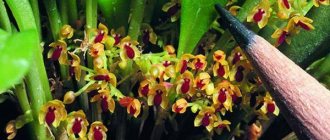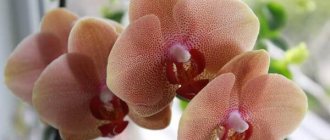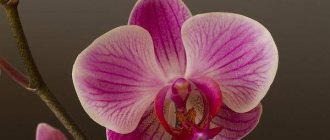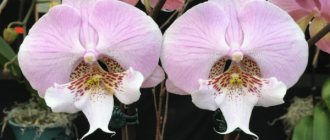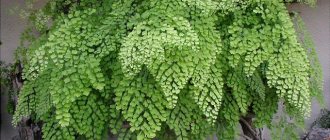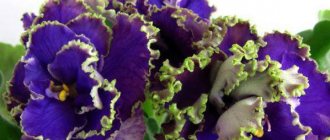Description of Phalaenopsis
Padova
This variety of orchid is native to Southeast Asia. It has a pleasant pink color with a golden center . As a rule, it produces 1-2 peduncles with 7-10 flowers on it.
It blooms mainly in autumn-winter ; in summer it does not show much activity. It reaches a height of 65 cm, the size of flowers is about 9 cm.
Hybrid Phalaenopsis Padova.
This hybrid variety is not very whimsical , its maintenance conditions are as follows:
- Air temperature 18-20 degrees;
- Humidity more than 60%;
- Moderate lighting.
Important! Phalaenopsis Padova is very responsive to sudden changes in temperature: if the room is less than 16 degrees, the plant can shed unopened buds and leaves.
It reproduces, like all other phalaenopsis, by throwing out and then replanting babies. This is best done in spring or early autumn.
During the period of vegetative growth, it is recommended to feed a little with special fertilizers for orchids. If you take good care of the Padova variety, the plant can live for about 7 years and delight its owner with constant flowering.
Palermo
This type of phalaenopsis is very popular among all orchids. It differs from all its relatives in its unusual appearance: delicate flowers with a beautiful pale pink color.
Palermo is distinguished by its unusual appearance: delicate flowers with a beautiful color of pale pink.
Description of Palermo:
- The petals have small streaks of cream color;
- The plant grows up to 60 cm in height, the size of flowers can be up to 8 cm;
- The Palermo variety is a hybrid orchid and is very easy to care for;
- The temperature should be within 15-18 degrees, the air humidity should be quite high;
- Additional humidity can be created by spraying, but this must be done carefully so as not to wet the blooming flowers and leaves, as this can cause the development of a fungal infection.
Advice! It is necessary to fertilize several times a week in the summer; in winter and autumn, the amount of fertilizer can be reduced to 1 time every 7-14 days.
Plants need to be watered as the soil dries out. The plant is very lush and blooms profusely due to its small flowers.
The dormant period between flowering is 1-2 months. If properly cared for, the plant can produce 2-3 flower stalks. See what a blooming Palermo orchid looks like in the photo below.
Photo of a blooming Palermo orchid.
Of particular interest are the hybrid varieties Palermo trilips and peloric.
Phalaenopsis Trilips is unique for its beautiful flowers with petals that are shaped like triangles.
Peloric is a designation for a form of phalaenopsis flowers that is atypical for this species, which was formed due to a genetic failure or mutation. Many lovers adore pelorics for their uniqueness and beauty. The colors of these varieties of orchids range from light lilac to deep violet with cream stains.
And here is a video with the Palermo variety:
Pandora
This hybrid Phalaenopsis variety is distinguished by its appearance:
- On long peduncles there are white flowers with a burgundy center ;
- The length of the peduncle can reach 50-55 cm in height;
- The diameter of the flowers is small - up to 7 cm;
- During flowering, up to 7-9 flowers can form on one stem;
- The Phalaenopsis Pandora orchid blooms almost all year round , with short dormant periods of 1 month.
Pandora is very popular in the Philippines.
This phalaenopsis variety is very popular in the Philippines .
Care will not require excesses from the hostess:
- The temperature is the same as for other varieties of orchids,
- Humidity should be high
- to water the plant when the soil dries out.
- Allowed to spray . Feeding should be moderate in the summer and plentiful during the period of vegetative growth,
- to replant after the plant has finished blooming.
- Reproduces from “babies”, which can be formed with proper care,
- The Palermo variety does not like bright sunlight ; it is best to place the pot with the plant on the windowsill in the early morning or in the evening.
In addition to white flowers, this variety boasts an unusual coloring: the delicate white flowers have bright lilac specks, while the center remains burgundy.
Peabody
This is a bright orchid that will warm you with its color in the cold season. It is distinguished by its bright fiery color.
Phalaenopsis Peabody is distinguished by its bright fiery color.
Phalaenopsis Peabody was bred in a hybrid way, has up to 2 peduncles , the size of the flowers is 7-9 cm. Up to 10 flowers can be placed on one peduncle. The plant can grow 55-75 cm in height. In the middle of the bright yellow flower there is a soft pink center.
The lifespan of this variety is 5-7 years with proper care. It is not necessary to maintain high temperatures, but it is necessary to observe conditions of high air humidity. This can be done with regular spraying.
Planting soil required by Phalaenopsis Peabody is a universal substrate for orchids.
It is recommended to water this variety in the following way: lower the pot into a container of water so that it covers it halfway. Keep in this form until the substrate is completely saturated.
It blooms mainly in winter and spring, the duration of dormancy is from 1 to 2 months (as a rule, this is the hot summer season).
What colors does the plant come in?
The exotic orchid flower has an endless variety of colors and shades. Meet:
- white;
- yellow;
- red;
- lilac;
- burgundy;
- pink;
- purple;
- green;
- plain and with various patterned inclusions and stripes.
At home
Purchased specimens for indoor floriculture can be of the most fantastic colors. Such flowers are divided into two categories:
- hybrids for home cultivation;
- artificially colored plants.
The bright colors of the latter fade as they grow and become white. Hybrid varieties of orchids developed through selective breeding retain their color palette throughout their entire life cycle.
Decorative colors of flowers using special compounds not only quickly disappear, but can also lead to disease and death of the plant.
Natural in nature
In the wild, the natural colors of orchids have a huge variety of variations, but blue, cyan, pure purple and black shades do not exist in nature.
Artificially bred
Hybrid varieties of these flowers contain mixtures of bright colors that are specially bred by breeders. Among them there are already blue, violet colors, as well as new combinations of the natural spectrum.
Main features of proper landing
Priming
For planting these hybrid varieties, standard orchid soil .
It must include:
- A little peat
- oak bark,
- Drainage system (such as coconut chips or pieces of foam).
The right containers
It is recommended to plant the plant in special plastic containers of various diameters; they have holes at the bottom for water access.
Such a container can be placed in a bright orchid pot, which is ideal for your interior. It can be plastic, ceramic or glass.
Technology
You need to plant the plant as follows: pour a little drainage into the bottom of the orchid container, then a small amount of substrate. Place the plant there and cover it with the rest of the soil.
The nuances of transplantation
This should be done after the plant has stopped blooming .
Reproduction is carried out from children that are thrown out by the orchid in the same way.
Do not tamp or press on the plant, as this can damage the root system.
Watering after transplantation is allowed no earlier than a week later.
You can feed 30 days after transplantation.
Other sunny varieties
Lycaste aromatica
The most popular type of yellow orchid. The ovoid petals are connected by a rhizome. The bright green stems are elliptical in shape. There are from two to five or even ten flower stalks. During flowering, one large flower appears on each arrow, up to 20 cm in diameter. The petals are yellow and have a waxy sheen.
Oncidium Zelemnia Midas peloric (Onc. Zelemnia Midas peloric)
This is a very beautiful mutant plant, which got its name due to the unusual shape of the petal , very different from the standard. The horizontal petals merge at the ends, forming a simple triangle shape. Flowers look very unusual due to their asymmetry. Bright orange specks are visible scattered on the yellow petals, which makes this variety very unusual and rare.
Zelemnia pelorik is not only canary-colored; this shade is diluted with pink and red tones, which form spots or stains on the surface of the petal.
Cattleya Potinara Burana Beauty
This variety has long and narrow stems that are colored rich green. The orchid grows up to 70 cm in height with a powerful peduncle on which up to 5 buds with a diameter of up to 16 cm are located.
The petals of this variety have a pleasant yellow color with burgundy accents.
Home care rules
Conditions of detention
The optimal conditions for growth and flowering are :
- Temperature within 16-20 degrees;
- Air humidity not less than 60%;
- Moderate lighting.
Watering and fertilizing
water as the soil dries out:
- In the summer, 1-2 times a week,
- In winter, once every 2 weeks.
You can use fertilizer during the period of vegetative growth. It is recommended to take special mineral fertilizers for orchids.
Disease Prevention
If the basic rules of watering are not followed, the orchid can be affected by fungal diseases. To prevent them, you can use special fungicidal agents .
To prevent ticks, special acaricidal agents are used; they must be used to treat the plant 3-4 times a day if ticks are suspected. You also need to adhere to the correct temperature and humidity so that the plant does not get sick.
Growing conditions
The question of how to care for a mini orchid is usually not difficult for gardeners. Plants require fertilizing during active growth at intervals of 2 weeks and replanting every 2-3 years.
Temperature
In the room where tropical flowers are kept, the temperature must be maintained from +180 to +250 C. They must be protected from drafts and sudden temperature changes, otherwise they may die. At night, the room should not cool down by more than 50 C. If in the summer the pot can be kept on the balcony or loggia, then in the winter it must be brought into a warm room.
Flower placement in the house
Exotic plants require good lighting. At the same time, they should be protected from direct sunlight to prevent burns to the leaf plates.
Air humidity
Mini orchids feel uncomfortable in conditions of high air humidity; in such conditions, their root system can rot. The best humidity level is 30% to 40%. If the air is too dry, the plants may drop their buds. You can keep containers of water nearby and practice spraying. This helps regulate humidity.
Substrate
It is recommended to grow small orchids not in a substrate containing tree bark, but in sphagnum moss. It retains moisture for a long time, so you can’t water it too often, otherwise the roots may rot.
Pot
Planting containers are usually small, about 8 cm in diameter. They can be placed inside flowerpots that match the interior. The walls of the pot should be transparent. This provides light access to the roots and allows you to monitor their condition.
Lighting
Mini orchids should receive moderate lighting. They require protection from direct rays that can cause burns. In the winter months, additional lighting does not hurt.
Watering mode
The frequency of watering depends on the substrate. It is recommended to moisturize plants by immersion in fresh, clean, settled water. Its temperature should be 50 C higher than the air in the room. If there is moss in the pot, reduce watering. Moisture must be added after the soil has dried.
